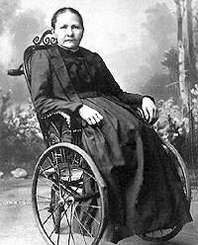Margarete Steiff

Margarete Steiff (July 24, 1847 – May 9, 1909), was a seamstress who in 1880 founded Margarete Steiff GmbH, making toy stuffed animals.
Biography
Born in Giengen, Germany, Margarete was the daughter of building contractor Friedrich Steiff and his wife Maria Margarete, née Haehnle. At eighteen months old Margarete contracted polio and was to be affected by the illness for the rest of her life. Both of her feet suffered paralysis and she had restricted use of her right arm. Her parents were keen for her to live a full life and investigated many medical treatments with little success. As a small child she was moved around in a small hand-pulled cart by her sisters and other children. In her later reminiscences she recalls 'All the children gathered round me and I organised games in which I was the centre of attention. However, the older children often ran off and then I was left babysitting the tiny tots' [1] Despite her disabilities Margarete regularly attended school throughout her childhood and it was in the needlework classes of Frau Schelling that she learnt her future profession, even though sewing without the full use of both hands must have presented difficulties.
Later Margarete attended needlework classes at the Giengen Town Hall, and became an accomplished zither player, teaching others to play to earn some money. Her savings allowed her to buy a sewing machine, the first owned in the town of Giengen, and this led to another opportunity to earn income. Margarete was often working on trousseaus for the town folk and by her mid twenties was making fashionable clothes and travelling to other towns to work and visit family, sending her cart ahead of her and travelling by Post-Coach.[2]
In 1877 Margarete opened a felt store and began making felt underskirts, which had just become fashionable, for the firm of Christian Siegle in Stuttgart. She was soon able to employ people to work for her and it became a thriving business. 'At this time I came across a pattern for a toy elephant. Felt was the ideal material for this toy and the filling would be of the finest lambswool. Now I could make these as gifts for the children in the family and I tried out the patterns in various sizes'.[3] In1879 the US magazine Delineator published a pattern for a cloth mouse, rabbit and elephant, other animal patterns followed and the German magazine Modenwelt reproduced these patterns. Maragrete made many of these toys and gave them as gifts to friends, and by 1880 she started to sell them in small numbers. In the following years she widened her range of small cloth animals based on the magazine patterns, but with small alternations to the cloth used and accessories.
In 1892 her small company applied for a Patent 'for making of animals and other figures to serve as playthings', the Patent number was DRP 66996, but this was later withdrawn when contested by another German toy manufacturer. Margarete's brother Fritz realised that there was an opportunity to sell large numbers of these toy animals and he took some samples to the market in Heidenheim, coming away with many orders.Production and turnover increased each year as did the variety of toys on offer. Pull-along and ride-on toys were also added with the development of metal frames inside the toys. By 1889 the company moved into a larger building, which had a corner shop where the toys and fabric could be displayed for sale. The words 'Felt-Toy-Factory' were painted in large letters on the outside wall. Next came a printed catalogue for customers to order from and the business grew from strength to strength.
Margarete Steiff made up all the samples of any new toys herself so she could be aware of any problems that might arise in production. Between 1897 and 1899 the Steiff company was designing and making 'dancing bear' toys. Rather than the familiar teddy bear, these were standing figures carrying sticks and with rings through their noses imitating the real life dancing bears that travelled from town to town to provide entertainment at this time, or pull-along bears on wheels.[4] By 1902-3 the soft toy bears were given movable joints and a large shipment of toys had been sent to a New York showroom, but there was not much interest in the plush toy bears that were displayed there. In March 1903 Richard Steiff took jointed soft toy bears to a spring fair in Leipzig and they caught the eye of an American buyer, who ordered 3000. The Steiff bear went on to become the most famous and sought after make of teddy bears growing from one woman's determination to overcome disabilities and to create a business based on her needlework skills.
Maragarete Steiff died on 9 May 1909 just before her 62nd birthday. The flags in Giengen flew at half mast.
References
- ↑ Cieslik, Jurgen & Marianne (1989). Button in Ear. Germany: Marianne Cieslik Verlag. p. 7. ISBN 3-921844-18-5.
- ↑ Cieslik, Jurgen & Marianne (1989). Button in ear. Germany: Marianne Cieslik Verlag. p. 10. ISBN 3-921844-18-5.
- ↑ Cieslik, Jurgen & Marianne (1989). Button in Ear. Germany: Marianne Cieslik Verlag. p. 11. ISBN 3-921844-18-5.
- ↑ Cieslik, Jurgen and Marianne (1989). Button in Ear. Germany: Marianne Cieslik Verlag. pp. 26–27. ISBN 3-921844-18-5.
External links
| Wikimedia Commons has media related to Margarete Steiff. |
- http://www.museocasalis.org/
- BBC News: "Teddy bear celebrates 100th birthday"
- Margarete Steiff on IMDb